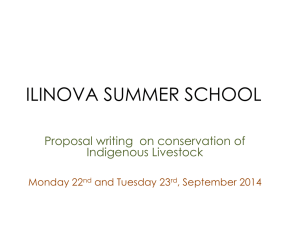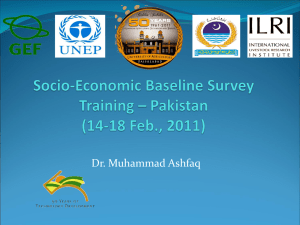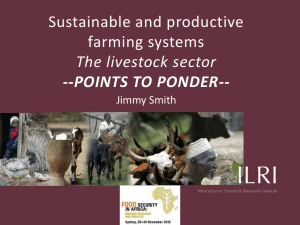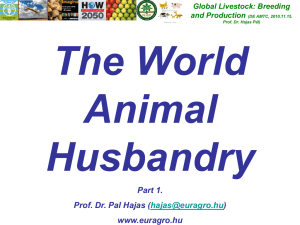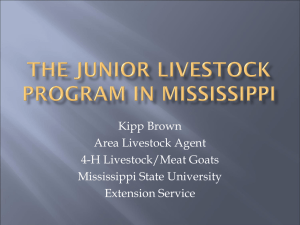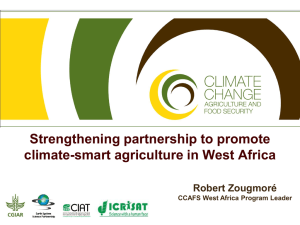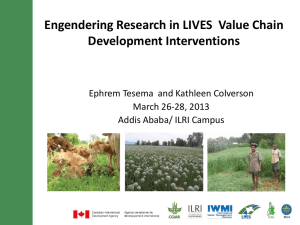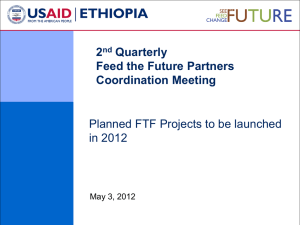Global Livestock: Breeding and Production
advertisement
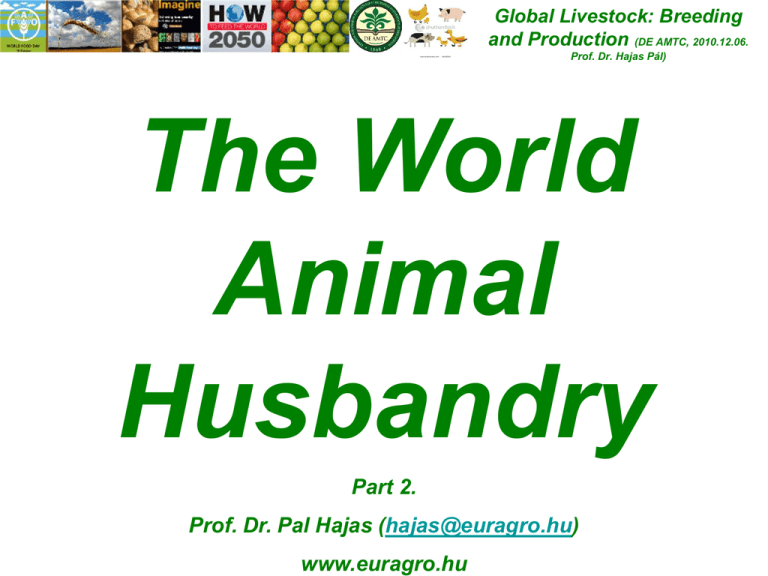
Global Livestock: Breeding and Production (DE AMTC, 2010.12.06. Prof. Dr. Hajas Pál) The World Animal Husbandry Part 2. Prof. Dr. Pal Hajas (hajas@euragro.hu) www.euragro.hu Global Livestock: Breeding and Production (DE AMTC, 2010.12.06. Prof. Dr. Hajas Pál) Livestock and Animal Production(1) There has been rapid global expansion of •production and •consumption of animal products which is expected to continue to grow. Global Livestock: Breeding and Production (DE AMTC, 2010.12.06. Prof. Dr. Hajas Pál) Livestock and Animal Production(2) While traditional livestock systems contribute to the livelihoods of 70% of the world's rural poor, increasingly the emerging large-scale operations with sophisticated technology and international trade cater for the rapidly growing markets for meat, milk and eggs. Global Livestock: Breeding and Production (DE AMTC, 2010.12.06. Prof. Dr. Hajas Pál) Livestock and Animal Production (3) Livestock production currently accounts for one third of the global crop land which is used to produce feed for animals and competes for land, water, energy and labour, and is being challenged by the vagaries of climate change and socio-economic pressures. Global Livestock: Breeding and Production (DE AMTC, 2010.12.06. Prof. Dr. Hajas Pál) Livestock and Animal Production (4) Increasing productivity - making the most efficient use of the production inputs - throughout the whole livestock sector will be fundamental if the sector is to meet the growing demand for quality livestock products whilst minimising its impact on the environmental and the world’s natural resources. Global Livestock: Breeding and Production (DE AMTC, 2010.12.06. Prof. Dr. Hajas Pál) Livestock and Animal Production (5) Increasing productivity, especially in the small to medium scale production systems, is currently constrained by lack of skills, knowledge and appropriate technologies compounded by insufficient access to markets, goods and services, and weak institutions. Global Livestock: Breeding and Production (DE AMTC, 2010.12.06. Prof. Dr. Hajas Pál) Livestock and Animal Production (6) The result is that both production and productivity remain below potential, and losses and wastage can be high. Global Livestock: Breeding and Production (DE AMTC, 2010.12.06. Prof. Dr. Hajas Pál) Livestock and Animal Production (7) However, adapted breeds, local feed resources and animal health interventions are available, along with improved and adapted technologies that include sound animal husbandry, on and off -farm product preservation and valueadding product processing. Global Livestock: Breeding and Production (DE AMTC, 2010.12.06. Prof. Dr. Hajas Pál) Livestock and Animal Production (8) Together with supportive policies and institutions, they have the potential to substantially improve productivity, income generation and to make a major contribution to poverty reduction. Global Livestock: Breeding and Production (DE AMTC, 2010.12.06. Prof. Dr. Hajas Pál) Livestock and Animal Production (9) The global programme on animal production focuses primarily on •small-scale dairying, •small-medium scale poultry and, to a lesser extent, on •small ruminant systems Global Livestock: Breeding and Production (DE AMTC, 2010.12.06. Prof. Dr. Hajas Pál) Livestock and Animal Production (10) which can make a significant contribution to •improved livelihoods and •local economic development. This will be achieved through the provision of topical information, guidance and technical support. Global Livestock: Breeding and Production (DE AMTC, 2010.12.06. Prof. Dr. Hajas Pál) Livestock and Animal Production (11) What is „Animal Production?” Ethiopia Bio Farming: http://www.youtube.com/watch?v=_dWhHPSHW3E Global Livestock: Breeding and Production (DE AMTC, 2010.12.06. Prof. Dr. Hajas Pál) We must go to the source! How to handle our Global Animal Genetic Resources? Global Livestock: Breeding and Production (DE AMTC, 2010.12.06. Prof. Dr. Hajas Pál) http://lprdad.fao.org/cgi-bin/getblob.cgi?sid=-1,123 Exchange, Use and Conservation of Animal Genetic Resources Policy and regulatory options S.J. Hiemstra1, A.G. Drucker2, M.W. Tvedt3, N. Louwaars1, J.K. Oldenbroek1, K. Awgichew4, S. Abegaz Kebede5, P.N. Bhat6 & A. da Silva Mariante7 1 Centre for Genetic Resources, the Netherlands (CGN) of Wageningen University and Research Centre, the Netherlands 2 International Livestock Research Institute (ILRI) and School for Environmental Research, Charles Darwin University, Australia 3 The Fridtjof Nansen Institute, Norway 4 Institute of Biodiversity Conservation, Ethiopia 5 Ambo College, Ethiopia 6 World Buffalo Trust (WBT), India 7 EMBRAPA Cenargen, Brazil Global Livestock: Breeding and Production (DE AMTC, 2010.12.06. Prof. Dr. Hajas Pál) Characteristics, status and trends of AnGR and the livestock sector (1) Domestic animals supply •30% of total human requirements for food and agriculture and •70% of the world’s rural poor depend on livestock as a component of their livelihoods. Global Livestock: Breeding and Production (DE AMTC, 2010.12.06. Prof. Dr. Hajas Pál) Characteristics, status and trends of AnGR and the livestock sector (2) The global livestock sector consists of a •variety of production systems and •farm animals are used for a variety of functions. Global Livestock: Breeding and Production (DE AMTC, 2010.12.06. Prof. Dr. Hajas Pál) Characteristics, status and trends of AnGR and the livestock sector (3) Centuries of selective breeding and exchange of farm animals or germplasm among users within and across countries have resulted in the development of the current diversity of breeds and within-breed genetic diversity. Global Livestock: Breeding and Production (DE AMTC, 2010.12.06. Prof. Dr. Hajas Pál) Characteristics, status and trends of AnGR and the livestock sector (4) The exchange of AnGR •has played and •will continue to play an important role in breed and livestock sector development. Global Livestock: Breeding and Production (DE AMTC, 2010.12.06. Prof. Dr. Hajas Pál) Characteristics, status and trends of AnGR and the livestock sector (5) Although detailed quantitative data about gene flow between countries and continents is not available, different AnGR flow directions can be characterized to a large extent. Global Livestock: Breeding and Production (DE AMTC, 2010.12.06. Prof. Dr. Hajas Pál) International, regional and national law, as well as customary law at community levels, are all relevant for AnGR. Global Livestock: Breeding and Production (DE AMTC, 2010.12.06. Prof. Dr. Hajas Pál) International agreements with a general scope (CBD, WTO/TRIPS and WIPO Treaties also apply to AnGR. Throughout the study, the term AnGR refers to animal genetic resources used in or potentially useful for food and agriculture Global Livestock: Breeding and Production (DE AMTC, 2010.12.06. Prof. Dr. Hajas Pál) Currently, the exchange of AnGR is mainly regulated by •the transfer of private ownership (by private law contracts and customary law) and •is also influenced by zoosanitary regulations. Global Livestock: Breeding and Production (DE AMTC, 2010.12.06. Prof. Dr. Hajas Pál) As the implementation of international treaties with a general scope advances further, they may have an increasingly significant impact on AnGR exchange, use and conservation. Global Livestock: Breeding and Production (DE AMTC, 2010.12.06. Prof. Dr. Hajas Pál) While the special nature of agricultural biodiversity is recognized, the FAO Global Strategy and the FAO State of the World’s AnGR give the widely accepted orientation to all stakeholders Global Livestock: Breeding and Production (DE AMTC, 2010.12.06. Prof. Dr. Hajas Pál) What is „Animal Production?” Afghan Livestock Bazaar: http://www.youtube.com/watch?v=XNK4Lw1tT9g Global Livestock: Breeding and Production (DE AMTC, 2010.12.06. Prof. Dr. Hajas Pál) Conservation and sustainable use (1) It is generally accepted that •farm animal genetic diversity is under threat and that •action is needed to halt further losses. Global Livestock: Breeding and Production (DE AMTC, 2010.12.06. Prof. Dr. Hajas Pál) Conservation and sustainable use (2) In situations where AnGR currently have a low direct use value, they may nonetheless be particularly valuable for future use, which will require the public sector to play an important role in their conservation and management. Global Livestock: Breeding and Production (DE AMTC, 2010.12.06. Prof. Dr. Hajas Pál) Conservation and sustainable use (3) However, there is limited awareness about the importance of the conservation and sustainable use of AnGR among policy makers and major stakeholders in the livestock sector. Global Livestock: Breeding and Production (DE AMTC, 2010.12.06. Prof. Dr. Hajas Pál) Conservation and sustainable use (4) Genetic erosion may be minimised through •complementary ex situ (in vitro) and •in situ conservation approaches Global Livestock: Breeding and Production (DE AMTC, 2010.12.06. Prof. Dr. Hajas Pál) Conservation and sustainable use (5) Organised at •national, •regional and/or •global levels. Such approaches should take into account different views of the ‘unit of conservation’. Global Livestock: Breeding and Production (DE AMTC, 2010.12.06. Prof. Dr. Hajas Pál) Conservation and sustainable use (6) A variety of different strategies is available to stimulate in situ conservation, including strengthening of breeding capacity and programmes for local breeds. Global Livestock: Breeding and Production (DE AMTC, 2010.12.06. Prof. Dr. Hajas Pál) Conservation and sustainable use (7) Ex situ conservation requires •appropriate infrastructure and organisation, •technical capacity, •legal arrangements and •sustained funding. Global Livestock: Breeding and Production (DE AMTC, 2010.12.06. Prof. Dr. Hajas Pál) Conservation and sustainable use (8) The Boran story 1 The Boran, a medium-sized cattle breed of East African origin. The breed most widely kept primarily for beef production in the semi-arid zones of Kenya. Commercial ranchers prefer the Boran to Bos taurus breeds because of their relative adaptability to the local environment. Global Livestock: Breeding and Production (DE AMTC, 2010.12.06. Prof. Dr. Hajas Pál) Conservation and sustainable use (9) The Boran story 2 Achieved through generations of natural and artificial selection in conditions of high ambient temperature, poor feed quality, and high disease and parasite challenge. Boran genetic material is recommended as a means of improving beef production in other indigenous and exotic breeds in the tropics. Global Livestock: Breeding and Production (DE AMTC, 2010.12.06. Prof. Dr. Hajas Pál) Conservation and sustainable use (10) The Boran story 3 Genetic exports to Zambia, the United Republic of Tanzania, Uganda, Australia and the United States of America occurred from the 1970s to the 1990s. Export of Boran embryos to Zimbabwe and South Africa took place during 1994 and 2000. This market potential has been an incentive for farmers to improve the breed. By the 1970s, the Boran had undergone crossbreeding with B. taurus types, backcrossing, and within-breed selection (which was mainly based on visual appraisal guided by experience). Global Livestock: Breeding and Production (DE AMTC, 2010.12.06. Prof. Dr. Hajas Pál) Conservation and sustainable use (11) The Boran story 4 During the 1970s a recording scheme was initiated. Producers sent animal performance records routinely to the Livestock Recording Centre (LRC) for genetic evaluation. However, because of inconsistency and delays in the release of evaluation results, and the expenses associated with recording, most producers opted out of the scheme. In 1998, a bull performance testing project was implemented by the National Beef Research Centre in an attempt to evaluate bulls across various herds. Global Livestock: Breeding and Production (DE AMTC, 2010.12.06. Prof. Dr. Hajas Pál) Conservation and sustainable use (12) The Boran story 5 However, the performance testing could not be sustained because of a lack of funds. Recently, breeding objectives for Boran production systems have been developed. Systems are classified according to the sale age of the animals (24 or 36 months), levels of input (low, medium or high), and final goal (beef or dual purpose). Global Livestock: Breeding and Production (DE AMTC, 2010.12.06. Prof. Dr. Hajas Pál) Conservation and sustainable use (13) The Boran story 6 Traits of economic importance have been identified, and genetic parameters have been estimated for some of them. These traits include sale weight for steers and heifers, dressing percentage, consumable meat percentage, milk yield in dual purpose production systems, cow weight, cow weaning rate, cow survival rate, post-weaning survival rate, and feed intake of steers, heifers and cows. Genetic improvement of the Boran in Kenya is facilitated by the Boran Cattle Breeders’ Society (BCBS). Global Livestock: Breeding and Production (DE AMTC, 2010.12.06. Prof. Dr. Hajas Pál) What is „Animal Production?” The easy calving of Boran Cattle: http://www.youtube.com/watch?v=VxlApoWx8hE

